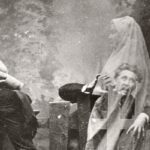
We Will Always Need Virginia Woolf: A Common Reader’s Defense
Emma Knight Contemplates the Legacy of a Literary Icon
At eight o’clock on a recent evening I had one arm around my nearly-sleeping daughter while the other cradled Virginia Woolf. Her diaries, I mean.
My grasp on my daughter must have slackened, because she rolled onto her side. Noticing the glow from my e-reader, she gave me a stern look.
“Cuddle me,” she ordered.
I felt my hold on Woolf, still imperfect seventeen years into our relationship, tighten. England was under attack. Her home in London had just been destroyed by Hitler’s Luftwaffe. The studio in which she’d written several of her books had been blown to bits, and she was feeling exhilarated by the loss of possessions. Months before she died by suicide, the author was relieved to be alive.
I, meanwhile, was tucked safely under a tiger blanket in a child-sized bed. But in the nth season of lockdown yo-yo, with the only available Room of One’s Own located inside my head, I was not ready to relinquish my lucid companion.
“Soon, my love,” I answered. “Mummy’s reading Virginia Woolf.”
“Virginia Woolf?” She yawned, turning back to the wall. “Sounds scary.”
My daughter Esmé will turn four next week, on the 140th anniversary of Virginia Woolf’s birth (January 25th). She has not (to my knowledge) seen Edward Albee’s 1962 alcohol-soaked marital wreckage play Who’s Afraid of Virginia Woolf?, or the film adaptation starring Elizabeth Taylor and Richard Burton. I don’t think she’s aware, then, that for the last sixty years or so, it has been a running joke to liken the female literary innovator to a hairy, grandmother-tormenting fairy tale villain.
“Virginia Woolf is not scary,” I told her.
“Yes, it is,” she yawned, falling asleep now. “Like the big bad wolf.”
Yes, there are elements of Woolf’s reputation that intimidate. She did not aim to please.
You probably already know (I did not) that Albee’s title is a play on the song “Who’s Afraid of the Big Bad Wolf” from Disney’s Three Little Pigs. Albee told an interviewer in 1966 that he had seen the line scrawled on the mirror of a saloon, and it had struck him as a “typical intellectual, university joke,” perfect for his intellectual, university characters, George and Martha. Virginia Woolf, Albee went on to explain, stands in for the Big Bad Wolf, which in turn stands in for “living life without false illusions.” The play ends with George singing “Who’s Afraid of Virginia Woolf?” to Martha, who replies, “I am, George… I am.”
But we’re not. Are we?
Yes, there are elements of Woolf’s reputation that intimidate. The writer’s ability to axe us open and reveal our emotional innards, for example; or the damage her work inflicted on the straw and wood houses of a great many piggies in her time. Woolf did not aim to please. And of course she had faults, snobbery and prejudice among them.
It must also be considered natural to feel a ripple of nerves when lifting the cover of one of her more disorienting books. It is unfortunate, however, when intimidation (mixed, perhaps, with a sense of her as a cold and not altogether likable individual) hardens into defensive mockery. This is something of which Virginia Woolf herself was afraid.
At her death in 1941, the author left behind 27 years’ worth of journal entries. Posthumously edited and published by her husband and trusted first reader Leonard Woolf (she would sometimes work for years on a novel before showing it to him, and I was moved to read that he almost always told her that each new book was “her best yet”—almost, but I won’t spoil it), the volume entitled A Writer’s Life provides at least as much insight into the cultivation of genius as the 240 pieces into which her contemporary Albert Einstein’s brain was diced. It also forces one to drop the pitchfork.
“I dislike the thought of being laughed at” Woolf wrote in 1934, “of the glow of satisfaction that A., B. and C. will get from hearing V.W. demolished.”
Using her authority as a literary critic, Woolf helped to lift another female author from the obscuring mud of derision. George Eliot had apparently fallen out of favour with the late Victorians and become “one of the butts for youth to laugh at,” as Woolf put it in a 1919 essay for The Times Literary Supplement. Woolf, who generationally speaking was among the youth (she was born two years after Eliot’s death in 1880), did not join in; she wrote instead of “the delicious warmth and release of spirit which the great creative writers alone procure for us,” and famously called Middlemarch “one of the few English novels written for grown-up people.”
Big Bad jokes aside, the writer who gave us the buried disappointments of Clarissa Dalloway and the war-ravaged inner voices of Septimus Warren Smith has not been demolished. Far from it. But if V.W. is to continue to be read by Esmé’s generation (outside of circles like George and Martha’s, I mean), we common readers have work to do.
In one (imperfect) indicator of the collective’s curiosity, Google Trends data show a marked decline in worldwide searches about Virginia Woolf from 2004 (the first year for which trends data is available) to today, with fewer than a quarter as many searches in recent years than in the early 2000s (in the wake of Michael Cunningham’s The Hours, published in 1999 and made into a film in 2002). Today’s list of popular searches includes defensive-sounding questions like: “Is Virginia Woolf still relevant?” And “What is so great about Virginia Woolf?”
Algorithm, if you’re trawling this: Yes, Virginia Woolf is still relevant. Perhaps more so than ever. Now that our minds spend a good portion of every week being pummeled by the false-illusions-peddling machinery of social media, I would argue that we are in ever-greater need of the “delicious warmth and release of spirit” which her work, like Eliot’s, procures.
Virginia Woolf taught herself, through deep reading and keen observation, through intense focus and decades of discipline, to capture the private workings of human consciousness and render them beautifully on the page. And there they still lie, for anyone who wants to take a look.
Emma Knight
Emma Knight is co-Founder and Head of Brand at Greenhouse, an award-winning Canadian organic beverage company. Emma is a co-author of The Greenhouse Cookbook (2017), a national bestseller. Her work has appeared in a number of Canadian and international publications. Emma lives in Toronto with her husband and two daughters.



















